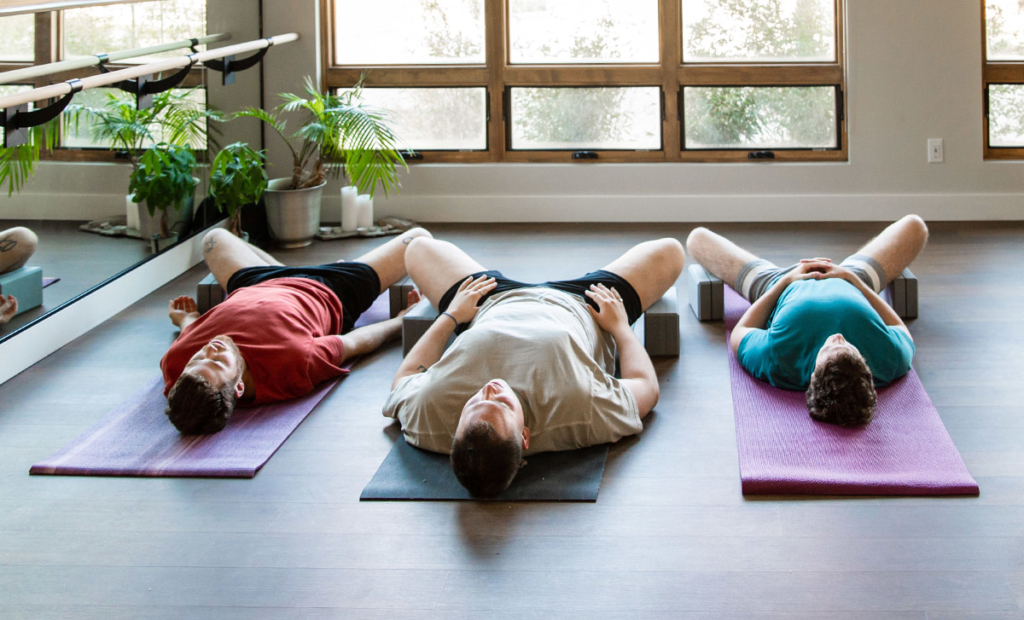This entry was posted on Aug 14, 2024 by Charlotte Bell.

Supta Baddhakonasana (Reclining Bound Angle Pose) is most often practiced as a Restorative pose. In the ultimate restorative version, we use all the good stuff—Yoga Blocks, a Standard Yoga Bolster and a Yoga Blanket or two. But we can also practice Supta Baddhakonasana in a more simplified way. A Yoga Mat and a couple Yoga Blocks just might be enough for you to enjoy an easeful respite in the pose.
As a very bendy person, I historically resisted using support under my thighs in Supta Baddhakonasana. Blocks under the thighs were for stiffer folks, I thought. But recently I’ve noticed my sacroiliac (SI) joints feeling achy after practicing it. As I thought about what might be the cause, I realized that it might be the extreme angle of my thighs.
My thighs fall easily to the floor in the pose. As a result, I can feel that my glutes actually compress my SI joint. If I stay more than a minute—and I always want to stay more than a minute—my SI joint suffers. Placing a Yoga Block under each thigh still confers the pose’s many benefits, but without the drawbacks. I’ve begun suggesting that all my students—especially the bendy ones—support their legs in the pose.
Supta Baddhakonasana Benefits
Supta Baddhakonasana is one of only a small handful of yoga poses that are appropriate to practice after eating. By expanding the abdomen, it facilitates the flow of energy and food matter into the lower quadrants of the abdomen, where the small and large intestines live. In my experience, the spaciousness this pose creates helps stimulate movement to assist the let-go process.
Supta Baddhakonasana relieves the contracted or heavy sensation we often feel after over-eating, and can relieve menstrual cramps. Because this pose is very relaxing, it helps move us into the rest-and-digest (parasympathetic) side of our autonomic nervous system, which stimulates digestion and helps relieve stress.
How to Practice Reclining Bound Angle Pose with Yoga Blocks
- Gather your props: Yoga Mat, two Yoga Blocks and a Yoga Blanket (optional). I like to place a folded blanket under my head and neck for a bit of extra support and comfort.
- Sit in Dandasana (Staff Pose) on your mat. Place the soles of your feet together and bend your knees out to the sides. Place a block under each thigh. Make sure that the blocks are far enough under your thighs that they are supporting them.
- Place your hands behind you and lean back. Then bend your elbows so that you’re resting on your forearms with your fingers pointing toward your glutes.
- Now push your fingers into your glutes to encourage your tailbone to point toward your heels.
- Lie back onto the floor, placing a folded blanket under your head and neck if you like.
- Relax here and breathe for 2 to 10 minutes.
- To leave the pose, place your hands under your thighs. Use your hands to support your legs as you move them toward your chest. Then place your feet on the floor, hips-width apart, with your knees upright, in Constructive Rest Position. Relax here as long as you like.
About Charlotte Bell
Charlotte Bell discovered yoga in 1982 and began teaching in 1986. Charlotte is the author of Mindful Yoga, Mindful Life: A Guide for Everyday Practice and Yoga for Meditators, both published by Rodmell Press. Her third book is titled Hip-Healthy Asana: The Yoga Practitioner’s Guide to Protecting the Hips and Avoiding SI Joint Pain (Shambhala Publications). She writes a monthly column for CATALYST Magazine and serves as editor for Yoga U Online. Charlotte is a founding board member for GreenTREE Yoga, a non-profit that brings yoga to underserved populations. A lifelong musician, Charlotte plays oboe and English horn in the Salt Lake Symphony and folk sextet Red Rock Rondo, whose DVD won two Emmy awards.

